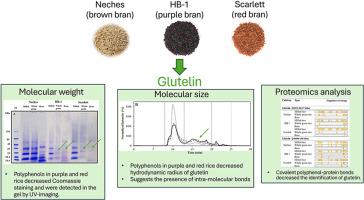多酚介导的共价键对不同米糠颜色的谷蛋白结构变化的影响
IF 3.9
2区 农林科学
Q2 FOOD SCIENCE & TECHNOLOGY
引用次数: 0
摘要
色素水稻和非色素水稻品种含有不同种类的多酚。在色素水稻中,多酚会与谷蛋白(水稻中的主要蛋白质部分)发生共价键合。通过 SDS-PAGE 和 HPSEC 分别研究了多酚类别对谷蛋白分子量和大小的影响。通过 LC-MS/MS 对谷蛋白进行了蛋白质组分析。使用的水稻品种的米糠颜色分别为棕色(Neches)、紫色(HB-1)和红色(Scarlett),主要包括酚酸、花青素和黄烷-3-醇/原花青素。由于多酚的浓度较低,碾米中谷蛋白的分子量和大小与蛋白质组鉴定结果相似。多酚对谷胱甘肽的共价修饰降低了谷胱甘肽的鉴定量。酚酸对谷蛋白的结构几乎没有影响。花青素和黄烷-3-醇/原花青素在全谷物大米以及 HB-1 和 Scarlett 的麸皮中通过分子内键使谷蛋白结构更加紧密。多酚与蛋白质之间的相互作用可用于从色素大米中提取具有所需流变特性的食品配料。本文章由计算机程序翻译,如有差异,请以英文原文为准。

Polyphenol-mediated covalent bonds on glutelin structural changes in rice with different bran colors
Pigmented and non-pigmented rice cultivars contain different polyphenol classes. Covalent bonding of polyphenols with glutelin, the major protein fraction in rice, can occur in pigmented rice. The effects of polyphenol class on glutelin molecular weight and size were studied via SDS-PAGE and HPSEC, respectively. The proteomic analysis of glutelin was performed via LC-MS/MS. Rice cultivars with brown (Neches), purple (HB-1) and red (Scarlett) bran colors mainly comprising phenolic acids, anthocyanins, and flavan-3-ols/proanthocyanidins, respectively, were used. Glutelin in milled rice exhibited similar molecular weight and size and proteomic identification due to the lower concentration of polyphenols. Covalent modification of glutelin by polyphenols decreased the amount of identified glutelin. Phenolic acids caused little or no structural changes of glutelin. Anthocyanins and flavan-3-ols/proanthocyanidins in whole grain rice and bran of HB-1 and Scarlett caused a more compact glutelin structure through intra-molecular bonds. Polyphenol-protein interactions may be utilized to tailor food ingredients from pigmented rice with desired rheological properties.
求助全文
通过发布文献求助,成功后即可免费获取论文全文。
去求助
来源期刊

Journal of Cereal Science
工程技术-食品科技
CiteScore
7.80
自引率
2.60%
发文量
163
审稿时长
38 days
期刊介绍:
The Journal of Cereal Science was established in 1983 to provide an International forum for the publication of original research papers of high standing covering all aspects of cereal science related to the functional and nutritional quality of cereal grains (true cereals - members of the Poaceae family and starchy pseudocereals - members of the Amaranthaceae, Chenopodiaceae and Polygonaceae families) and their products, in relation to the cereals used. The journal also publishes concise and critical review articles appraising the status and future directions of specific areas of cereal science and short communications that present news of important advances in research. The journal aims at topicality and at providing comprehensive coverage of progress in the field.
 求助内容:
求助内容: 应助结果提醒方式:
应助结果提醒方式:


